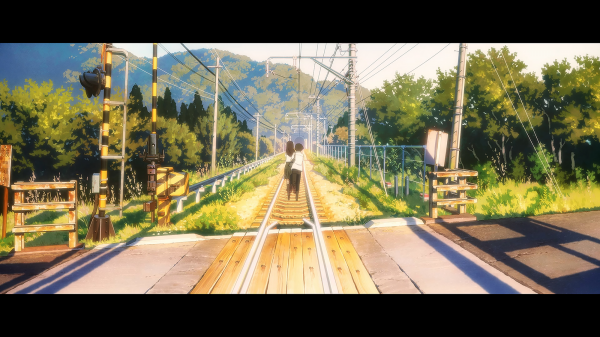What if the possibility of reclaiming lost moments in life lay within one’s grasp? What sacrifices would be necessary, and how might these actions reshape one’s destiny? These philosophical musings form the crux of the animated film “Tunnel to Summer, Exit of Goodbyes”. Premiering on November 3rd for a limited run in the U.S., cinephiles have the option of delving into both subtitled Japanese and English dubbed renditions.
In the Mix of Animation & Soundtrack
The film is a visual delight with its vivid hues and intricate shading echoing a melancholic atmosphere, reminiscent of Makoto Shinkai‘s acclaimed works. While the soundtrack is largely engaging, the placement of certain songs occasionally seems out of sync with the tone of the accompanying scenes. Although, this is simply a minor critique and not so jarring as to pull one completely out of the world of the film.
The Enigma of Urashima Tunnel

Central to the narrative is Kaoru’s unexpected encounter with the enigmatic Urashima Tunnel. This locale, steeped in urban myths of wish fulfillment, draws inspiration from the revered Japanese folktale of Urashima Tar?. In this legend, fisherman Urashima Tar? rescues a turtle and, as gratitude, is transported to a dragon palace beneath the sea. There, he spends what feels like a few days but returns to the surface to discover many years have passed. The theme of time’s irreversible nature of is parallel to Kaoru’s experiences with the tunnel.
The Journey of Discovery and Romance

Navigating the mysteries of the tunnel, Kaoru (Suzuka, Ouji) embarks on a quest to fathom its genuine essence and the cost of wishes realized. Kaoru’s compatriot in this endeavor is Tokyo transfer student Anzu (Iitoyo, Marie) . United by their challenging personal circumstances, their alliance evolves, marked by heartfelt interactions and mutual aspirations. Through these endeavors the film portrays the essence of their emerging romance, prompting viewers to speculate if they can actualize their desires without risking their blossoming relationship. The climax delivers an emotional tempest, rewarding the audience’s engagement with its introspective plot.
Final Thoughts on Adaptation and Execution

A cinematic viewing of this film is certainly recommended during its short stint in theaters. Nonetheless, the transition from light novel to silver screen is not without some minor shortcomings. Subtle details sometimes get overlooked, resulting in occasional vagueness. Certain plot components can sometimes feel a bit drawn-out (more than the depth of the scene allows) affecting the movie’s rhythm. However, the overall strength of the story, the amazing visuals, and the solid vocal performances (in the original Japanese) make for what is, without a doubt, a very entertaining watch.
